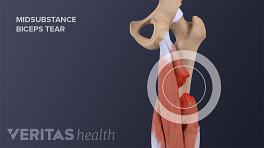Running can aggravate or create a number of lower back problems. Improved conditioning of the lower back and other muscles involved in running can help prevent back injuries.
In This Article:
- How to Run Safely with Back Pain
- Exercises to Lessen Back Pain While Running
- What to Do When Back Pain Interferes with Running
Stretch the Hamstrings
Hamstring stretches promote flexibility and reduce muscle tightness in the lower back and legs.
The hamstrings—the long muscle in the back of each thigh—provide essential support to the body while running. If the hamstrings are tight, the back muscles may be exposed to more pressure and strain during running.
See Common Running Injuries: Hip or Thigh Pain
Ideally, hamstring stretching should be done at least twice daily, even on non-running days, to help reduce the strain on the back.
Example of hamstring stretching routine:
- Sitting on the floor with the legs outstretched, the hamstrings can be stretched by gradually reaching for the toes and holding that position for several seconds before resting and repeating.
- While holding the stretch, count to ten, and over time build up to a 30 count. Try to repeat the stretch 3 to 4 times with the same interval of rest between stretches.
- Avoid jerking or forcing a stretch too far—a good stretch may be uncomfortable but should not be painful.
Stretching the hamstrings thoroughly before a run or workout can help activate those muscles and prevent injury.
Engage in Muscle Toning and Stamina Training
Engaging in regular muscle toning and stamina training activities can help to reduce the risk of back pain and injury. Core strengthening exercises are a critical component in protecting the lower back against running-related damage.
Examples of exercises include:
- Pilates exercises can help to develop core abdominal stamina and flexibility, and strong, supportive core muscles help take pressure off of the back. Pilates uses body resistance to improve flexibility and muscle coordination.
- Body weight exercises, such as front planks, side planks, and dips, can boost overall conditioning and protect against lower back injuries. As a general rule, anyone who has back pain is advised to avoid crunches or sit-ups, as these can roll the lower back against the floor. A core strengthening program using an exercise ball is an excellent option.
- Resistance work that uses resistance bands and free weights can help work the buttocks, hamstrings, legs, and lower backs.
Exercises that strengthen the hips and gluteal muscles are especially helpful in reducing the risk of low back pain. These exercises can also help reduce the risk of knee pain.
See Common Running Injuries: Back Pain
Try to incorporate a regular routine of muscle toning and stamina exercises several times a week.
The philosophy of a conditioning and stamina program should be lower resistance (i.e. lighter weights) and higher repetitions. For example, with any particular exercise, plan to push a comfortable weight or against a comfortable resistance for 20 to 30 repetitions as opposed to a higher weight or resistance for 8 to 10 repetitions. As an added benefit, conditioning and stamina training has also been shown to improve overall endurance over time. 1 Tanaka H, Swensen T. Impact of resistance training on endurance performance: a new form of cross training? Sports Med 25 (1998); 3: 191-200. http://www.ncbi.nlm.nih.gov/pubmed/9554029. Abstract accessed February 4, 2015.
Cross Train
Building cross training days into one’s schedule is another way to reduce the risk of back injury injuries. Cross training provides cardiovascular training while offering rest to the muscles most used in running workouts. Cross training activities may include:
- Swimming
- Bicycling or spinning
- Martial arts
- Dancing
- Yoga
These are suggestions rather than a complete list. It is best to choose a cross-training activity that is personally enjoyable.
- 1 Tanaka H, Swensen T. Impact of resistance training on endurance performance: a new form of cross training? Sports Med 25 (1998); 3: 191-200. http://www.ncbi.nlm.nih.gov/pubmed/9554029. Abstract accessed February 4, 2015.







